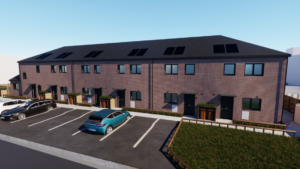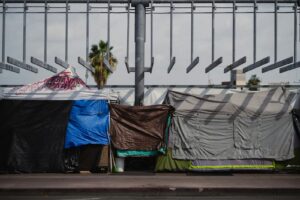How to deliver housing in rural communities…

Photo supplied by Lawrenny Estate
A recent report highlighted the lack of affordable housing as a key barrier to economic growth in rural areas, but a new £10m development in Pembrokeshire could provide the answer to the rural housing crisis.
The mixed-use development was recently granted planning permission by national park planners and will see up to 39 new homes, including seven affordable properties, a traffic-free village square and workshops built in the village of Lawrenny.
The development will also see the construction of a biomass district heating system as well as improvements to existing village infrastructure.
New Start spoke to Lawrenny Estate director Adrian Lort-Phillips about the new development and the need to ensure the long-term sustainability of rural communities.
 You were recently granted planning permission to build 39 new homes on the Lawrenny Estate in rural Pembrokeshire. How important is it to ensure we build more homes in the countryside?
You were recently granted planning permission to build 39 new homes on the Lawrenny Estate in rural Pembrokeshire. How important is it to ensure we build more homes in the countryside?
If we are going to ensure the long-term sustainability of our communities in rural areas – something which I believe is absolutely vital if our national consciousness is to remain even remotely connected to the countryside – then it is essential to build homes there. The idea that time should stand still in our villages and that they should be preserved in aspic is the very idea which kills our communities stone dead and drives away those who have lived and worked in them for generations.
A recent report by the House of Lords select committee on the rural economy highlighted a lack of affordable housing as a big issue in the countryside. Do you see it as a big issue and how vital is it for rural life that young people have places to live?
I read that report and, although it was not aimed at Wales, the findings were true of our country as well. Our young need to be able to afford to live in the communities to which they belong. They are our sons and daughters. Those of us who make our livings in rural areas need them and want them to carry on doing what we do. As an employer, as a business, we are delivering more public good to this small area by being able to employ local people than we would if we had to hire teams in from elsewhere. So, for as long as there are thriving businesses in the countryside, we need to make sure we have young people living here and growing up to be part of those businesses. That’s the virtuous circle that sustains our communities.
What else can be done to help rural economies thrive in your opinion?
We need to smash the barriers that impede rural businesses. We are very much encumbered by planning constraints and poor understanding of how rural economies work. Consider the impact that a business such as ours (that will only ever invest within a few square miles) can have on a rural community. We are investing nearly £8m on two projects. That investment falls entirely within a ward with a population of less than 600. That’s an investment of around £14,000 per head of population. If a car company says it will invest £100m on a new plant in Birmingham, politicians will fall over themselves to make that happen, and the media will rightly champion it, even if the local per capita investment ends up being far less. Why is this? Our governments, local and national, need first to value vibrant rural communities, in the same way they might value urban communities. Once they realise the importance and value of sustainable communities they will do what they can to better support rural businesses that sustain those communities.
Do you think the current planning system makes it easy or hard for developments in the countryside to get permission?
We have had a grim planning journey. The plethora of designations (SSI, SAC, Natura 2000 etc) on our doorstep don’t make it easy, of course. But it is the slow, disjointed and detached way planning is applied in the countryside that really does the damage. When I walk through a town or city I am struck by the sense of purpose all around me. I know from my time as a journalist, the pressure urban elected members put on officers to deliver effectively for their constituents. Things need to happen, we all need to get on. That urgency dissipates in the countryside. There seems to be no pressure on officers and their consultees to play their part in our economic survival. That’s what makes it hard to get permission in the countryside.
Do there need to be exemptions/special rules for developments in the national parks?
In 1945 the Hobhouse Committee, architects of England and Wales’ national parks, gathered in my grandfather’s house up the hill from the village and settled the boundaries of what we now know as Pembrokeshire Coast National Park. This park would be different to others. Yes, it would have its remote uplands and wild coastline. But it would also encompass stretches of closely managed farmland, villages, even whole towns. It would be settled over busy, working communities. This came to be a problem when it took on the role of planning authority. By the 1990s it seemed almost to celebrate the fact it had no statutory duty to foster economic wellbeing and social cohesion of the communities over which it ruled. The fact you had a planning authority with no prerogative to deliver economic good was lethal. Planning is one of the most powerful levers of an economy. So yes, we need special rules within our national parks. Where there is wilderness, protect and nurture it. Where there is a living, working community protect and nurture it too. If you think that is going to create a conflict, give up your planning powers within those communities.
There are a lot of environmental/sustainable aspects to the Lawrenny Estate development. Tell me a bit about them and why they are important?
We had from the outset wanted this development to carry the best possible credentials in terms of sustainability. It was written into the brief for the RIBA architectural competition. I could never have envisaged we would wait 12 years before being ready to build. In that time things have moved on tremendously. I am keen to push ahead with a development that enables people to live a carbon neutral existence. That aspiration includes shared district heating and a local energy network incorporating generation, sharing and storage. We want that energy capacity to power our transport wherever possible. I have approached Cardiff University to see if they would be interested in working on the project with us. It’s early days, but it’s very exciting.
Nationally, do you think there needs to be a greater focus on the specific housing needs of people living in rural areas. What would you like to see done?
I would like to see community land trusts set up on land bordering existing settlements. I would like a bespoke help to buy package in rural areas that sees local people who want to purchase able to get a home of their own. I would like greater focus by planning authorities on the actual needs of local people in terms of housing instead of applying a universal approach that’s tailored towards towns and cities. I would also like to see planners encourage more small developments of 5+ properties coming forward in villages. These can be game changers for a small community. People living in rural areas are very resilient and don’t ask much. However, right now there’s a heavy and inhibiting blanket over rural communities. Remove that and they will flourish.















